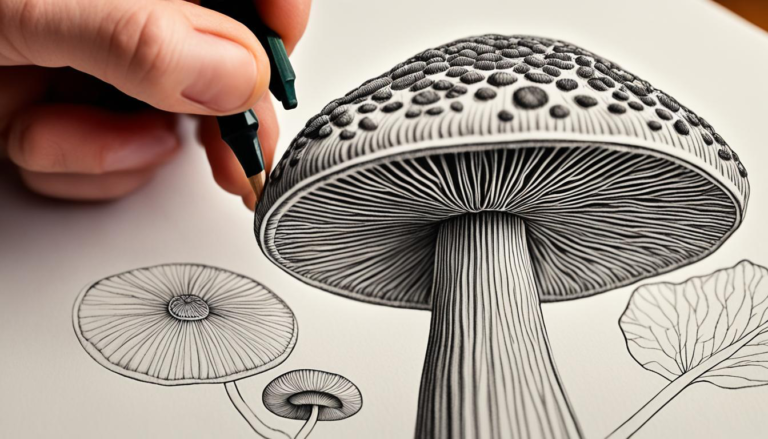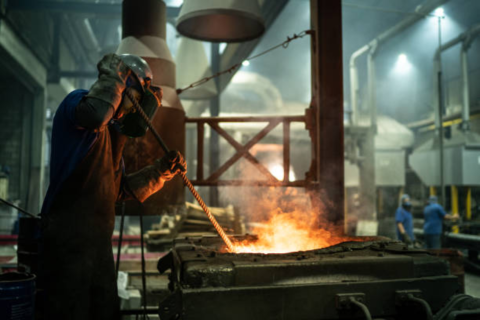Explore the world of mushroom sketching and improve your fungi art skills. This guide offers expert tips and techniques to help you draw the beauty and details of mushrooms. It’s perfect for both beginners and experienced artists. You’ll learn how to make beautiful, realistic mushroom drawings that show nature’s beauty.
Start your journey in mushroom sketching and learn the secrets to excel. This article covers everything from choosing the right tools to mastering shading and textures. Get ready to be inspired by nature and let your art grow on the page.
Capturing Nature’s Whimsy: The Art of Mushroom Sketching
Sketching mushrooms is a fun and rewarding hobby. It lets you explore the unique shapes of these amazing fungi. It also helps you connect more with nature. Here, you’ll learn why sketching mushrooms is great and what you need to start.
Why Sketch Fungi?
Sketching mushroom species has many benefits. It can:
- Improve your skills in observing and appreciating nature
- Offer a calming and creative activity
- Help you learn about the special features of different fungi
- Encourage you to find new mushroom sketching subjects in your area
Whether you’re an experienced artist or just starting, mushroom sketching is rewarding. It lets you connect with the beauty of fungi illustration inspiration around you.
Essential Supplies for Mushroom Sketching
To start with mushroom sketching, you’ll need some basic sketching materials and drawing tools. These include:
- A sketchbook or paper for drawing
- Pencils (2H, HB, and 6B) for sketching and shading
- Erasers (kneaded and vinyl) for making your drawings look better
- Colored pencils or watercolors (optional) for adding color and texture
- A portable easel or clipboard for drawing outside
With these simple sketching supplies, you’re ready to capture the beauty and details of the mushroom sketching benefits around you.
A Step-by-Step Guide to Mushroom Sketching
Bringing mushrooms to life on paper is a fun creative journey. It doesn’t matter if you’re an expert or just starting with fungi sketching. This guide will give you the key techniques to make realistic mushroom illustrations.
Start by looking closely at the shapes, textures, and details of your mushroom. Capturing the nuances of different mushrooms is crucial for a true representation. Notice the cap, stem, gills, and any unique features of your mushroom.
- Begin with a basic mushroom sketching tutorial. Lightly draw the mushroom’s shape and size.
- Refine the details, using focusing on drawing techniques to highlight the cap, stem, and gills’ textures and patterns.
- Try out shading methods to give your mushroom depth and dimension. See how light and shadow affect the surface to show depth.
- Focus on capturing textures, like the smooth cap or delicate gills. Use hatching, crosshatching, and stippling to get the look you want.
By using these step-by-step mushroom sketching tutorials, you’ll get better at making realistic mushroom illustrations. They’ll show the beauty and variety of these fascinating fungi. Enjoy exploring and trying new things, and let your artistic side shine in your fungi art.
Embracing Imperfections: Techniques for Realistic Mushroom Drawings
Sketching mushrooms means embracing their natural imperfections for a lifelike look. Each type of mushroom has unique textures and details. These are key to capturing their essence.
Capturing Textures and Details
Mushrooms have everything from delicate gills to rugged stems. Their textures are a big part of what makes them stand out. By paying attention to these details, you can bring them to life in your drawings.
Try using hatching, cross-hatching, and stippling to capture their patterns. These techniques help show the unique character of mushrooms.
Adding Depth with Shading and Highlights
Shading and highlighting are key to making your mushroom sketches pop. Use different values to add depth and dimension. Think about how light affects the mushroom’s surface to place shadows and highlights right.
This approach will give your mushrooms a real sense of form and volume. It makes them look more lifelike.





